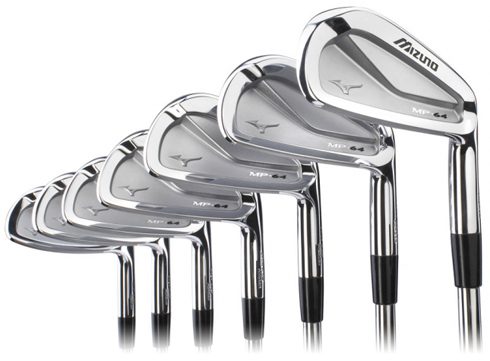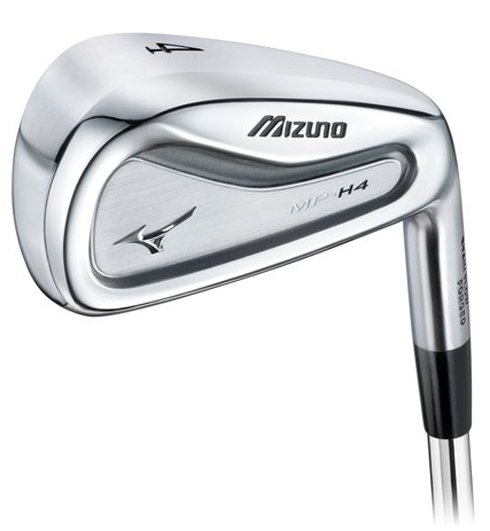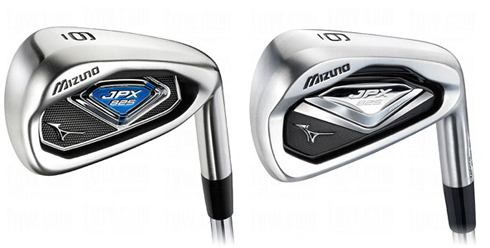 This September Mizuno released four new sets of irons aimed at all levels of golfers. For the better player they have released the MP-64, a better players cavity back. For those looking for something a bit more forgiving without giving up too much of the workability, there is the new MP-H4 which targets scratch golfers to those with handicaps up to around 15. In addition to the two new MP sets, there are new JPX irons as well (which if you remember replaced the MX line last year). They are the JPX-825 and the JPX-825 Pro.
This September Mizuno released four new sets of irons aimed at all levels of golfers. For the better player they have released the MP-64, a better players cavity back. For those looking for something a bit more forgiving without giving up too much of the workability, there is the new MP-H4 which targets scratch golfers to those with handicaps up to around 15. In addition to the two new MP sets, there are new JPX irons as well (which if you remember replaced the MX line last year). They are the JPX-825 and the JPX-825 Pro.
New MP Irons
Let’s start by looking at the two new additions to the MP line of clubs. The first set is the MP-64 irons, which are the successor to the MP-63s. Looking at this years club compared to its predecessor there are a few similarities. As with the majority of Mizuno irons, the MP-64s are Grain Flow Forged using 1025E “Pure Select” mild carbon steel. It is the use of this steel and forging technique that gives Mizuno clubs the buttery feel that they have become known for. The MP-64s also feature a Flow Thickness Diamond Muscle pad in the cavity of the irons, which is an evolution of the Diamond Muscle design found in the MP-63s. According to Mizuno, the Diamond Muscle pad optimizes the performance and flow throughout the entire set. As alluded to previously, these irons are made with the better player in mind, and according to Mizuno are aimed at golfers with handicaps between +2 and 10. However, that is not to say that they are not playable, as the long irons feature a deeper cavity to give more playability while the short irons have a shallower cavity to increase workability. Mizuno irons, especially those in the MP line, are all about feel and that is why Mizuno developed and uses Harmonic Impact Technology (HIT) to optimize the sound and feel of the irons. They also feature a Tour confirmed sole design and compact head to give the ability to alter shots easily.

The other new addition to the MP line is the MP-H4 irons, which give the most playability and forgiveness that Mizuno has ever put into one of their better players irons. Like the MP-64s, the MP-H4s are Grain Flow Forged from the same 1025E mild carbon steel to give the same soft feel that players of Mizuno irons have become accustomed to. The clubs also feature a bit more offset than the MP-64s and are more forgiving due to the use of Advanced Hybrid Flow Design. What this means is that the long and mid irons (2-7) in the MP-H4 set are hollow while the short irons (8, 9, and PW) are a solid one piece. This gives more forgiveness in the long irons and mid irons while the ability to score remains with the short irons. It should also be noted that the mid irons (5, 6, and 7) have less hollow space than the long irons so that the transition from long to mid to short irons is a smooth one. To make the clubs playable across the entire set, Mizuno has made it so that the center of gravity is low and deep in the long irons to promote a higher launch and then moves up from there to increase the workability of the clubs.

New JPX Irons
While the MP-64 and MP-H4 irons are the new offerings for the better players in Mizuno’s Game Enhancement line, they have made two new additions to their Game Improvement line as well: the JPX 825 and the 825 Pro. Looking first at the 825 Pro, the clubs feature the same Grain Flow Forged technology found in the MP line to give mid-handicappers a taste of the soft feel of a Mizuno iron. The clubs feature a deep pocket cavity in the 4-7 irons giving the clubs a larger, more uniform COR area as well as producing a higher launch. The short irons do not have the pocket cavity and have a more compact head to increase maneuverability. While these clubs would be considered game improvement clubs, they can be played effectively by better golfers as well and are aimed at golfers with handicaps between six and 18.

In addition to the JPX 825 Pro there are the regular JPX 825 irons. These irons are aimed at the higher handicapper golfer and should fit the games of those between a 10 and 28 handicap according to Mizuno. The 4-7 irons feature a Max COR ultra pocket cavity design which gives the clubs a huge sweet spot and helps to maximize distance. The deep pocket cavity also helps to lower the center of gravity to produce a high launch. The 8-PW also feature a pocket cavity design to increase distance and forgiveness while increasing launch, but it is not as deep as it is in the long and mid irons. The clubs also feature a triple cut sole design for ideal turf interaction from nearly any lie on the course.
Both of the new MP clubs come in set make-ups of 3-PW and come stock with True Temper Dynamic Gold Shafts and Mizuno Golf Pride M-31 grips. The JPX clubs come in set make-ups of 4-GW and come stock with either the True Temper Dynalite Gold XP or the Fujikura Orochi shafts depending if you want steel or graphite. The Mizuno Golf Pride M-31 grip is also the stock grip. However, there are a number of different shafts and grips available in custom should you want something different.
The MP-H4s retail for $1100 while the MP-64s can be had for $1000. The JPX 825 and JPX 825 Pros come in at $700 and $900, respectively. The graphite option for the JPX 825 sereis is $200 more.

Why do most companies, including Titleist and Mizuno, feel the need to bling out their higher-handicap clubs. In this article, look at the MP64s – understated and elegant. They look like a player’s iron. Now look at the JPXs above, Big Metallica-looking logo and on the 825, it is a blingy-blue color.
Is this differentiation to show these game improvement irons are just that, limiting understated appearance to player’s club? Or has research shown that higher-handicappers like the bling?
I think the thing is that with game improvement irons there is so much more space in the cavity that they kind of have to put something there… A lot of time there is some sort of weighting being done and the logos and badges help with that. Also, the “Metallica” looking logo on them isn’t just on the JPX irons, it’s on all four sets and about the same size on each set. And for what it’s worth, it’s Mizuno’s logo (they call it the “run bird”).
my guess is that higher handicaps like bling. usually dont play that much and are draw to what appears to them as “cool” I imagine players irons look very plain to them. havent been around the game enough to appreciate the understated elegance that is typical of better player clubs
As a higher handicapper I certainly prefer the classic look over the blinged out look. I don’t know whether you guys would consider the R11 to be excessively blinged, but part of why I was happy to buy them was to do with the more classic (in my opinion) look compared to the RBZ or other similarly priced clubs.